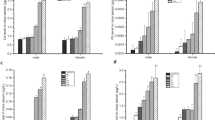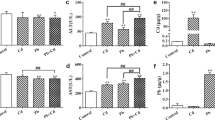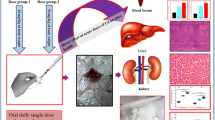Abstract
Although a large number of studies have been conducted on lead (Pb) and cadmium (Cd) exposure individually, information regarding the toxicity of combined Pb and Cd exposure is relatively limited. The present study aims to investigate the toxicity of Pb–Cd combination exposure and the corresponding mechanism. A heavy metal exposure model was established in mice by subcutaneous intragastric administration of Pb–Cd (50:1) for 35 days. Body weight, diet, hair state, mental state, liver index, haematological index, biochemical indicators and pathological section analysis were used to comprehensively evaluate toxicity. Then, classical oxidative stress indexes and lipidomics techniques were used to explore the potential mechanism. The results showed that Pb–Cd caused the mice to have low appetite, poor spirit, significantly reduced activity, slow weight gain and irritated or drying hair. Pb–Cd also caused liver enlargement, significantly increased aspartate aminotransferase (AST) and alanine aminotransferase (ALT) enzyme activities, and resulted in pathological changes to the liver. Prolonged Pb–Cd exposure led to significantly increased thrombocyte haematocrit (PCT), white blood cell (WBC), platelet (PLT) and monocyte (MON) counts and decreased red blood cell (RBC), haemoglobin (HGB), haematocrit (HCT) and lymphocyte (LYM) counts. Pb–Cd increased oxidative stress by increasing the activity of superoxide dismutase (SOD) and lactate dehydrogenase (LDH) and the content of malondialdehyde (MDA). Finally, Pb–Cd triggered lipid metabolism disorders by regulating linoleic acid, sphingolipid and glycerolipid metabolism.








Similar content being viewed by others
Data Availability
The datasets generated during and/or analysed during the current study are available from the corresponding author on reasonable request.
Change history
01 September 2022
A Correction to this paper has been published: https://doi.org/10.1007/s12011-022-03404-2
Abbreviations
- Pb:
-
Lead
- Cd:
-
Cadmium
- Cu:
-
Copper
- Zn:
-
Zinc
- Hg:
-
Mercury
- Ag:
-
Silver
- Mn:
-
Manganese
- KM:
-
Kunming
- SPF:
-
Specific pathogen free
- HESI:
-
Heated electron spray ionization
- RSD:
-
Relative standard deviation
- HE:
-
Haematoxylin-eosin
- FC:
-
Fold change
- VIP:
-
Variable importance for the projection
- UHPLC–MS/MS:
-
Ultra-high performance liquid chromatography–tandem mass-spectrometry
- Pb(CH3COO)2 :
-
Lead acetate
- CdCl2 :
-
Cadmium chloride
- ALT:
-
Alanine aminotransferase
- AST:
-
Aspartate aminotransferase
- SOD:
-
Superoxide dismutase
- MDA:
-
Malondialdehyde
- LDH:
-
Lactate dehydrogenase
- GSH-Px:
-
Glutathione peroxidase
- RBC:
-
Red blood cell
- WBC:
-
White blood cell
- HGB:
-
Haemoglobin
- PLT:
-
Platelet
- PCT:
-
Thrombocyte haematocrit
- HCT:
-
Haematocrit
- LYM:
-
Lymphocyte
- MON:
-
Monocyte
- QC:
-
Quality control
- PCA:
-
Principal component analysis
- OPLS-DA:
-
Orthogonal partial least multiplicative discriminant analysis
References
Chai WS et al (2021) A review on conventional and novel materials towards heavy metal adsorption in wastewater treatment application. J Clean Prod 296:126589
Mansoor S et al (2021) Biochar as a tool for effective management of drought and heavy metal toxicity. Chemosphere 271:129458
Kan X et al (2021) Contamination and health risk assessment of heavy metals in China’s lead–zinc mine tailings: a meta–analysis. Chemosphere 267:128909
Samuel MS et al (2021) A state of the art review on characterization of heavy metal binding metallothioneins proteins and their widespread applications. Sci Total Environ 775:145829
Bi M et al (2019) Molecular mechanisms of lead-induced changes of selenium status in mice livers through interacting with selenoprotein P. Ecotoxicol Environ Saf 175:282–288
Reja D et al (2020) Blood lead level is associated with advanced liver fibrosis in patients with non-alcoholic fatty liver disease: a nationwide survey (NHANES 2011–2016). Ann Hepatol 19(4):404–410
Suljevic D et al (2019) Impairments of bone marrow hematopoietic cells followed by the sever erythrocyte damage and necrotic liver as the outcome of chronic in vivo exposure to cadmium: novel insights from quails. Environ Toxicol Pharmacol 72:103250
Park E et al (2021) Association between environmental exposure to cadmium and risk of suspected non-alcoholic fatty liver disease. Chemosphere 266:128947
Council N (2010) Guide for the care and use of laboratory animals eighth edition. Publication 327(3):963–965
Mabrouk M et al (2022) Hepatotoxic and neurotoxic potential of iron oxide nanoparticles in Wistar rats: a biochemical and ultrastructural study. Biol Trace Elem Res 200(8):3638–3665
Poole LG et al (2021) Von Willebrand factor exerts hepatoprotective effects in acute but not chronic cholestatic liver injury in mice. Toxicology 463:152968
Chen H et al (2022) Protective mechanism of Polygonum perfoliatum L extract on chronic alcoholic liver injury based on UHPLC-Qexactive plus mass spectrometry lipidomics and MALDI-TOF/TOF mass spectrometry imaging. Foods 11(11)
Li H et al (2022) Effects of dietary whole grain buckwheat and oat on benzo[a]pyrene-induced genotoxicity, oxidative and pyroptotic injury in liver of mice. J Funct Foods 93:105082
Bian L, Chen H, Zhou X (2021) Untargeted lipidomics analysis of Mori Fructus polysaccharide on acute alcoholic liver injury in mice using ultra performance liquid chromatography-quadrupole-orbitrap-high resolution mass spectrometry. Int Immunopharmacol 97:107521
Carlsson H et al (2022) Evaluation of polarity switching for untargeted lipidomics using liquid chromatography coupled to high resolution mass spectrometry. J Chromatogr B 1195:123200
Hu Q et al (2022) Integration of lipidomics and metabolomics for the authentication of camellia oil by ultra-performance liquid chromatography quadrupole time-of-flight mass spectrometry coupled with chemometrics. Food Chem 373:131534
Rehman AU et al (2021) Toxicity of heavy metals in plants and animals and their uptake by magnetic iron oxide nanoparticles. J Mol Liq 321:114455
RagabAboZaid OA et al (2021) Sofosbuvir plus ribavirin combination regimen boost liver functions and antioxidant profile in hepatitis C virus patients. Microb Pathog 150:104740
Zubrzycki A et al (2020) Fenofibrate impairs liver function and structure more pronounced in old than young rats. Arch Gerontol Geriatr 91:104244
Murakami I et al (2020) Analysis of pathological and clinical characteristics of cervical conization according to age group in Japan. Heliyon 6(10):e05193
Baraban E et al (2020) A subset of sinonasal undifferentiated carcinoma is associated with transcriptionally active high-risk human papillomavirus by in situ hybridization: a clinical and pathologic analysis. Hum Pathol 101:64–69
Wallace DR, BuhaDjordjevic A (2020) Heavy metal and pesticide exposure a mixture of potential toxicity and carcinogenicity. Curr Opin Toxicol 19:72–79
Briffa J, Sinagra E, Blundell R (2020) Heavy metal pollution in the environment and their toxicological effects on humans. Heliyon 6(9):e04691
Marvasi M et al (2019) Omics technologies for an in-depth investigation of biodeterioration of cultural heritage. Int Biodeterior Biodegradation 144:104736
Feizi N et al (2021) Recent trends in application of chemometric methods for GC-MS and GC×GC-MS-based metabolomic studies. TrAC, Trends Anal Chem 138:116239
Wu B et al (2021) Mass spectrometry-based lipidomics as a powerful platform in foodomics research. Trends Food Sci Technol 107:358–376
Khalid N et al (2021) Interactions and effects of microplastics with heavy metals in aquatic and terrestrial environments. Environ Pollut 290:118104
Bai H et al (2021) Microbially-induced calcium carbonate precipitation by a halophilic ureolytic bacterium and its potential for remediation of heavy metal-contaminated saline environments. Int Biodeterior Biodegradation 165:105311
Han H et al (2021) Mechanisms of Enterobacter bugandensis TJ6 immobilization of heavy metals and inhibition of Cd and Pb uptake by wheat based on metabolomics and proteomics. Chemosphere 276:130157
Méndez S et al (2021) Accumulation of heavy metals (Cd, Cr, Cu, Mn, Pb, Ni, Zn) in sediments, macroalgae (Cryptonemia crenulata) and sponge (Cinachyrella kuekenthali) of a coral reef in Moín, Limón, Costa Rica: an ecotoxicological approach. Mar Pollut Bull 173:113159
Lin Y, Lu J, Wu J (2021) Heavy metals pollution and health risk assessment in farmed scallops: low level of Cd in coastal water could lead to high risk of seafood. Ecotoxicol Environ Saf 208:111768
Yuan G et al (2014) Toxicological assessment of combined lead and cadmium: acute and sub-chronic toxicity study in rats. Food Chem Toxicol
Zou H et al (2020) Effects of cadmium and/or lead on autophagy and liver injury in rats. Biol Trace Elem Res. 198(4)
Nation JR et al (1990) Behavioral antagonism between lead and cadmium. Neurotoxicol Teratol 12(2):99–104
Haneef SS et al (1998) Effects of concurrent exposure to lead and cadmium on renal function in goats. Small Rumin Res 28(3):257–261
Paxton WA (2021) Generation of liposomes to study the effect of mycobacterium tuberculosis lipids on HIV-1 cis- and trans-infections. Int J Mole Sci 22
Martin-Perez M et al (2021) Lipid metabolism in metastasis and therapy. Curr Opin Syst Biol 28:100401
Saito K (2021) Application of comprehensive lipidomics to biomarker research on adverse drug reactions. Drug Metab Pharmacokinet 37:100377
Duan Y et al (2022) Responses of lipid metabolism and lipidomics in the hepatopancreas of Pacific white shrimp Litopenaeus vannamei to microcystin-LR exposure. Sci Total Environ 820:153245
Li X et al (2021) Integrative lipidomic and transcriptomic study unravels the therapeutic effects of saikosaponins A and D on non-alcoholic fatty liver disease. Acta Pharmaceutica Sinica B 11(11):3527–3541
Lewin TM et al (2008) Mice deficient in mitochondrial glycerol-3-phosphate acyltransferase-1 have diminished myocardial triacylglycerol accumulation during lipogenic diet and altered phospholipid fatty acid composition. Biochimica et Biophysica Acta (BBA) Mole Cell Bio Lipids 1781;(6) 352–358
Martano C et al (2015) Rapid high performance liquid chromatography–high resolution mass spectrometry methodology for multiple prenol lipids analysis in zebrafish embryos. J Chromatogr A 1412:59–66
Dong M-X et al (2021) Metabolomics profiling reveals altered lipid metabolism and identifies a panel of lipid metabolites as biomarkers for Parkinson’s disease related anxiety disorder. Neurosci Lett 745:135626
Zik JJ et al (2022) Caulobacter lipid A is conditionally dispensable in the absence of fur and in the presence of anionic sphingolipids. Cell Rep 39(9):110888
Tang H, Huang X, Pang S (2022) Regulation of the lysosome by sphingolipids: potential role in aging. J Biol Chem 298(7):102118
Funding
This work was supported by the National Natural Science Foundation of China (No. 81860738) and the Special Project for the Cultivation and Innovation of Academic New Seedlings of Guizhou Normal University ([2018]5769–27).
Author information
Authors and Affiliations
Contributions
All authors contributed to the study conception and design. Material preparation, data collection and analysis were performed by [HC], [CZ] and [XZ]. The first draft of the manuscript was written by [HC], and all authors commented on previous versions of the manuscript. All authors read and approved the final manuscript.
Corresponding authors
Ethics declarations
Competing Interests
The authors declare no competing interests.
Additional information
Publisher's Note
Springer Nature remains neutral with regard to jurisdictional claims in published maps and institutional affiliations.
The original version of this article unfortunately contained an incorrect version of Figure 5.
The original article has been corrected.
Supplementary Information
Below is the link to the electronic supplementary material.
Rights and permissions
About this article
Cite this article
Chen, H., Zhu, C. & Zhou, X. Effects of Lead and Cadmium Combined Heavy Metals on Liver Function and Lipid Metabolism in Mice. Biol Trace Elem Res 201, 2864–2876 (2023). https://doi.org/10.1007/s12011-022-03390-5
Received:
Accepted:
Published:
Issue Date:
DOI: https://doi.org/10.1007/s12011-022-03390-5




